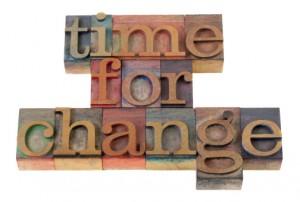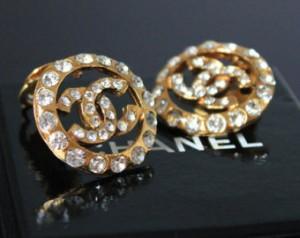 Yesterday I had change thrust upon me. It was while getting a haircut. I have been wearing my hair short for some time but wasn’t prepared for how short my hairstylist decided to cut it during yesterday’s appointment. I don’t hate what she did necessarily, I just wasn’t looking to go that short and really wasn’t up for dealing with the mental turmoil I knew I’d put myself through after the change happened. Mental turmoil including, but not limited to, the worry that the cut made me look bad, having to wonder what other people thought, the concern that I no longer looked pretty and the feeling of being so exposed without the safety of a hairstyle that I felt more confident about.
Yesterday I had change thrust upon me. It was while getting a haircut. I have been wearing my hair short for some time but wasn’t prepared for how short my hairstylist decided to cut it during yesterday’s appointment. I don’t hate what she did necessarily, I just wasn’t looking to go that short and really wasn’t up for dealing with the mental turmoil I knew I’d put myself through after the change happened. Mental turmoil including, but not limited to, the worry that the cut made me look bad, having to wonder what other people thought, the concern that I no longer looked pretty and the feeling of being so exposed without the safety of a hairstyle that I felt more confident about.
During whole cab ride home to Brooklyn from Manhattan with my husband I was terribly annoying to deal with. I knew this just by looking at my husband’s eye rolls his expressions annoyance every time I asked him again if he liked my hair. He chuckled at me with this “Oh honey, I love you so much, but GIVE ME A BREAK” over the countless times I used my the camera on my phone to gaze at my new super short bangs.
This forced made me think deeply about change in general, why we avoid it, even when we’re craving something new, what keeps us from changing and why we cling to safety in the familiar? With change thrust upon me I had no choice but to deal with the emotions of this change. But what about times when we have a choice about making a situation that we don’t care for better and don’t do anything about changing it? Why don’t we change?
Why we don’t change

Prior to my conversation with Dr. Zasio I had never given much thought to the anticipatory anxiety that comes with change and lettings go but since then I really do believe that anticipatory anxiety doesn’t just stop hoarders from throwing useless possessions away or making a change, it’s what keeps all of us from changing.
The story of the Chanel Earrings

It was about nine or ten years ago and I had been in business a relatively short time and I was still fascinated by just how psychological I was finding my work to be. I had no idea that helping a client clean a closet would evoke so much emotion in so many them. Despite this, I was still unprepared for the experience I was about to have with a client. My client, a lovely woman named Judy*, picked me up at the train station for her appointment and immediately burst into tears. We hadn’t even pulled out of the parking lot yet and she was already crying. It was at this point that I knew I was totally under-qualified to deal with a woman in such turmoil. Apparently, the anticipatory anxiety she was feeling about this appointment to let go of the things in her closet had really struck a chord. I listened on through the tears of just how many of the things in her life made her unhappy. She hated her job, hated where she lived, hated the relationship she was in since getting a divorce from her husband and it seemed just about everything in her life wasn’t working. There was little she could find in her life that made her feel good. My heart broke for her, yet at the same time I had a hard time understanding how anyone could live their life with this level of day-in and day-out misery.
We arrived at her home and I could immediately understand why she was so miserable. While her home wasn’t a horrible place, I remember it being cluttered with things from her past and there was a dark gloom that felt impossible to avoid…her closet was no different. The closet being the place I was hired to focus on, I started pulling items out from 1992. I remember this because it was the year I graduated from high school. As I flung booty shorts, that I knew she’d never wear again, shapeless tops and black dresses, that had faded from too many washes, from her closet I noticed Judy’s mood start to elevate and she started to find humor in just how much she held on to for no reason. As her closet lessened so did the weight of heaviness and despair she was feeling. I felt hopeful…until we got to her jewelry box.
We sat down at the table to sift through a box of old costume jewelry that Judy admitted to not touching for years. She didn’t need to tell me this, the dust that I wiped off the box alone was enough of an indication, as was how dated all the jewelry was when I looked inside. After careful inspection to see if anything was salvageable I slid the jewelry box towards Judy and told that she could probably let all of it go. I was pleasantly surprised to find that Judy was in agreement with me… with the exception of one thing, a pair of Chanel earrings. If you remember the 90′s you probably can recall the tacky, bold, double ‘C’ earrings that everyone wore. While these were authentic Chanel earrings they weren’t exactly worthy of holding on to. Remember, this was ten years ago, the 90′s had hardly made a comeback yet. Judy said to me, “I can let everything in this jewelry box go…except for these earrings.” It was then that Judy became emotional again and when I knew I was, yet again, in uncharted and very unqualified waters. I wanted to help this woman so desperately but worried I wouldn’t be able to. But, despite the fact that I don’t have any psychology training, Judy seemed to trust me. She went on, “It’s not that I plan on ever wearing these earrings again, lord knows they’re horrible. It’s just that….” Judy paused, “when I look at these earrings I think of my husband.” Judy saw in my face that her comment led me to think she still wanted to be married to her husband and explained further, “I don’t want to be married to him ever again, it’s not that. But when I look at these earrings I remember a time in my life that I was happy, when I used to do things and when I was content. I am so unhappy now, and if I part with these earrings I will have nothing in my life that makes me feel happy.” I looked at Judy with a combination of compassion and sadness for her. On the one hand I was so incredibly moved by this honest omission, yet sad for just how sad she found her life, and even sadder for her that she had to hold onto something like a pair of earrings to find the smallest bit of bliss. Judy looked at me and said, “Yes, I will get rid of everything, but not these earrings, not yet.” I looked across to Judy and just said with earnest compassion, “You keep these earrings as long as you want to” and followed up this statement with a warning. “One thing I am pretty sure about is until you do let them go, nothing that you dislike about your life is ever going to change.”
It’s not the change frightens us, it’s the “what ifs?” that do

When people find out what I do for a living the first thing they often say to me is, “Oh my God, I would love to be made over!” and I seriously wonder just how many people really want that, despite the fact that they are terribly bored with the same old, same old. Yet, as the saying goes, “The Devil you know is better than the Devil you don’t.” It’s just easier and less anxiety producing to stick with the norm.
Going back to Judy, because I’m sure you’re terribly curious as to how it all turned out for her in the end, it was months before I heard from Judy again and her silence had me concerned. I finally received an email from her telling me that she part with the earrings and once she did her whole entire life changed soon after She quit her job and got a better one, moved and broke up with the mediocre guy she was seeing. Most importantly Judy was happy and, after all was said and done, a bit embarrassed that a pair of earrings caused the level of anxiety and turmoil that they did. When I heard the news I was thrilled for her and told her that she had no need to be embarrassed over how she reacted to those earrings. For her, those earrings weren’t just a pair of earrings, they were a symbolic fork in the road where she had to decide to either let all the anticipatory anxiety over change keep her stuck or to push past it and move on. I was happy and proud for her bravery and all that came with it as a result.
If you’re bored, craving a change or feeling like doing something different, I can’t encourage you enough to just do it, seriously. If there is anything I’ve learned, even if a change winds up being a mistake, it’s a heck of a lot easier to deal with the fall out of that change than living with the paralysis of over-thinking it and not doing anything it about it.
*Name change to protect the identity of the client


